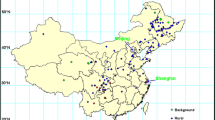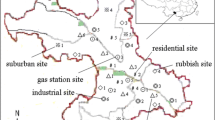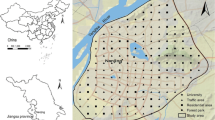Abstract
Representative agricultural soil samples from Tianjin, the third biggest city in China, were investigated for 16 PAHs in 2008 (n = 87) and 2012 (n = 60). Surface soil samples were air-dried and sieved. The total PAH (T-PAH) concentrations ranged from 29.7 to 4502.5 ng/g (mean value 619.9 ng/g) in 2008; and from 228.6 to 14,722.1 ng/g (mean value 1295.8 ng/g) in 2012. Bap concentrations exceeded the suggested standards at many sites. Bap and T-PAH spatial variations were represented with maps. The pollution status was also compared to many other cities. PAH soil pollution near the urban areas was found to be serious in both 2008 and 2012. Pollution at some sites became severer in 2012 comparing to that in 2008. Principal component analysis and two indicative ratios were employed to find the potential sources. The results in the 2 years both revealed that the major source of soil PAHs was coal combustion, which coincided well with the previous studies. The study added to the basic data of local PAH distribution, and pointed out a proper way for the government to reduce the pollution.
Similar content being viewed by others
Explore related subjects
Discover the latest articles, news and stories from top researchers in related subjects.Avoid common mistakes on your manuscript.
Introduction
Polycyclic aromatic hydrocarbons (PAHs), also known as polynuclear aromatic hydrocarbons, are fused aromatic rings without any heteroatoms or substituents. PAHs are widespread pollutants; more than 20 % of the carbon in the universe may be associated with PAHs. Many PAHs are strongly potent carcinogens and mutagens (Hoffman and Wynder 1971; Grimmer 1983; Perera 1997), PAHs are also potential and serious threats to human health over a long period (Menzie et al. 1992). So, the source, occurrence, transport and fate of PAHs in natural environments have been extensively studied.
Volcanic eruptions, plant emissions and natural fires were the natural sources of PAHs. Without anthropogenic pollution, the typical PAH concentrations in soil ranged from 1 to 10 ng g−1 (Edwards 1983). PAHs are also formed by incomplete combustion of carbon-containing fuels such as wood, coal, diesel, fat, tobacco, and incense (Kavouras et al. 2001). Influenced by human activities, PAH concentrations were highest in urban areas, then in suburban areas, and rural transect (Wang et al. 2007). Soils in suburban areas of cities were usually used as agricultural fields; therefore, they could strongly affect the food chain and human health of local residents. However, soils in suburban areas were also liable to be polluted by PAHs generated or transferred from cities. For example, in a mega-city in China, Tao et al. (2004) have revealed that agricultural soils and vegetables, especially those from the site located immediately next to an urban district, are severely contaminated by PAHs.
Many researches on the PAH pollution in Tianjin (N: 38°34′–40°15′; E: 116°43′–118°194′, Fig. 1), a China metropolis that covers 11 thousand square km2 and has more than 11 million population, were carried out before 2004 and most of these studies mainly laid their emphasis on urban area. PAH pollution to the agricultural soil was not investigated since 2004. So, in 2012, a systematic and extensive PAH survey was launched to evaluate the spatial–temporal variation, the pollution status changes and the sources in this area, as an extended study in 2008.
Materials and methods
In 2008, the sampling sites, the analytical method and the quality control results could refer to Lv et al. (2010). Samples collected in 2012 were analyzed as follows: cyclohexane, acetone (pesticide grade), acetate and dichloromethane (pesticide grade) were purchased from Fisher (Fair Lawn, NJ, USA). EPA M-610, 1 mL 0.1 mg/mL and EPA M-525-IS, 1 mL 2.0 mg/mL in acetone were from Accustandard Inc. (CT, USA) were used for standard and 2D-labeled surrogate standards separately. 2 D-surrogate was spiked (40 mg/L, 25 μL) before sample pretreatment in all samples. The sampling sites in suburban districts of Tianjin are illustrated in Fig. 1. All samples were sampled in October 2012. Total 60 soil samples (0–5 cm soil layer, 1 kg each) were collected, each of which was composed of 10–20 subsamples collected within the 10 × 10 m2 of sampling site. Samples were kept in dark and then transported to the laboratory. In the lab, the samples were air dried, ground, sieved through a 50 mesh sieve, and stored at −20 °C before analysis.
Accelerated solvent extraction (ASE) was used for extraction (Lv et al. 2009). 16.0 g sample was weighed, mixed with 5 g silica and poured to 34 mL ASE cell. Extraction solvent was used as acetone:dichloromethane (1:1). The extraction temperature and pressure were set at 120 °C and 1500 psi separately. The extracts were collected after 5 min extraction twice, evaporated to near-dryness and reconstituted with 9 mL cyclohexane:acetone (1:1). The extracts then were cleaned with GPC (LC Tech, Germany). Cyclohexane:acetone (1:1) with flow rate at 5.0 mL/min was used as mobile phase; the pressure was set at 130/140 mbr. 1340–3380 s elution was collected. The elutions were concentrated to nearly dry and the solvent was replaced with 2 mL dichloromethane. Florisil cartridges were used for further cleanup. 5 mL dichloromethane was used to activate the columns by flowing through the column under gravity. Then, samples were drawn through the activated column slowly by a vacuum pump. Finally, dichloromethane was used to elute the PAHs three times (3 mL each time). The eluents were concentrated to 1 mL under gentle nitrogen gas flow before being injected into the gas chromatography–mass spectrometer (GC–MS).
PAHs were quantified on Agilent 6890 gas chromatography with Agilent 5973N mass spectrometer with electron impact ion source. The instrumental parameters referred to the study in 2008 (Lv et al. 2010). Spiked tests indicated that recoveries of 16 PAHs were 64.6 % (naphthalene)–111.9 % (benzo(a)pyrene, Bap) with relative standard deviation (RSD) (n = 3) 1.3 % (fluorene)–16.5 % (naphthalene). The detection limits varied in 0.16–9.36 ng/g depending on the analytes. The recoveries of surrogate in all samples ranged from 71.1 to 107.2 %.
Results and discussion
The PAH level in soil samples are shown in Table 1. It can be seen that the total range and average concentrations of tested PAHs (T-PAHs) in 2012 are 228.6–14,722.1 and 1295.8 ng/g, respectively, and they are obviously higher than 29.7–6734.7 and 619.86 ng/g of 2008 (Lv et al. 2010), which were found in four suburban districts. This phenomenon reveals that PAH pollution at some sites did not improve and even worsened in the 4 years.
T-PAH spatial distribution is clearly shown in Fig. 2. It is clearly shown that more sampling sites near urban areas were with higher T-PAHs compared to those sites far from the urban areas. It also revealed that the soils near the urban areas were seriously polluted, especially to the upwind (south-west) and downwind (north-east) site. These areas were more readily affected by the highly developed industrial areas and busy traffic. In 2012 sampling, rural sites far from urban areas, such as site 5, 15, 37, 13, 14 in the north-east, 34 in the south-west were further monitored, the results showed that PAH concentrations in these rural transects were much lower than the other sites. The long distance from the human activities in city should account for the PAH pollution decrease.
Figure 3 shows the toxic equivalents quantity (TEQ) of ∑16 PAHs based on Bap toxicity values. TEQ distributions appeared with similar trends as T-PAH distributions. The highest TEQ values in 2008 and 2012 were both detected in Dongli district which was located the nearest to the urban areas. The highest TEQ value in 2012 was 2235.8 ng/g and much higher than that of 2008 (1200 ng/g).
Maliszewska (1996) has proposed a classification method based on the T-PAH concentrations. If the T-PAH concentration was less than 200 ng/g, the soil should be classified as non-contaminated soil; 200–600 ng/g as weakly contaminated soil, 600–1000 ng/g as contaminated soil, and 1000–10,000 ng/g as heavily contaminated soil. According to this classification, 31 of total 60 sites should be classified at least as contaminated soil in 2012. In 2008, more than 36.3 % sites in Xiqing, 40.9 % in Dongli, 34.8 % in Jinnan and 15.0 % in Beichen were classified at least as contaminated soil. The ratio in 2012 (51.7 %) was much higher than those in 2008. Few recommendation or guideline of T-PAHs in soil were found even worldwide, Bap concentrations were found always linear with T-PAHs and often used as indicative parameter, so Bap concentrations were also employed to evaluate the pollution status in this study. Figure 4 shows the Bap concentrations. Canadian Soil Quality Control Standard (the black line, 100 ng/g), and the target of polluted soil treatment in Netherlands (the grey line, 25 ng/g) were illustrated. 51.7 % (31/60) sites exceeded the grey line, 12.0 % (12/60) sites exceeded the black line in 2012. In 2008, 45.5 % sites in Xiqing, 50 % in Dongli, 52.2 % in Jinnan, 30.0 % in Beichen exceeded the grey line, 13.6 % sites in Xiqing, 27.3 % in Dongli, 8.7 % in Jinnan exceeded the black line. Generally similar pollution status was observed in 2012 and 2008.
Comparison of PAH soil pollution in this study and in many other cities is listed in Table 2. PAH concentrations were much higher than those reported in most previous studies, except Iskenderun, an industrial area in Turkey. The results were even only a bit lower than those monitored in the urban areas in Shanghai.
Principal component analysis (PCA) is a powerful and useful method in the PAH source identification (Li et al. 2006; Cincinelli et al. 2007). Pa, Flu, Pyr, Ant and HMW PAHs were typical representation of coal combustion (Harrison et al. 1996). High contents of Flu and Ant represent coking sources; Baa and Bap represent household cooking and gas combustion (Rogge et al. 1993). In this study, high loading values of all PAHs except Acp (0.287), and Acpy (0.842) were found in 2012 results in which one component was identified to account for 88.3 % variance. The results coincided well with those in 2008 (Lv et al. 2010). So, coal combustion was verified as one of the primary sources. Fl/(Fl + Pyr) and Baa/(Baa + Chr) were two indicative ratios also usually used to identify the possible sources. Fl/(Fl + Pyr) higher than 0.5 or Baa/(Baa + Chr) higher 0.35 hinted that coal combustion predominated the PAH sources (Sicre et al. 1987; Yunker et al. 1999, 2002). Figure 5 shows that Fl/(Fl + Pyr) at 81 sites in 2008 and 58 sites in 2012, Baa/(Baa + Chr) at 65 sites in 2008 and 50 sites in 2012 were all indicative for the PAH sources from coal combustion, suggesting that the main sources of PAHs are still relative to coal combustion.
Conclusion
The total concentrations of tested PAHs (T-PAHs) and TEQs in 2012 were found with similar spatial distributions with the results reported in 2008. However, PAH pollution at some sites was not improved and even worse in the 4 years. Concentrations of Bap at many sites were higher than the suggested standards. T-PAH and Bap spatial variation in soil was illustrated with map. It revealed that serious PAH soil pollution was still found at sites near the urban areas. Some sites at the downwind side of the urban areas were found with much higher PAH concentrations, which was also an apparent reflection of the human activities. PCA results indicated that coal combustion was the predominant PAH soil source, and it was further conformed by two diagnostic ratios. The results will help the local government to take corresponding steps to control the PAH soil pollution in this area.
References
Cincinelli A, Bubba MD, Martellini T, Gambaro A, Lepri L (2007) Gas-particle concentration and distribution of n-alkenes and polycyclic aromatic hydrocarbons in the atmosphere of Prato (Italy). Chemosphere 68:472–478
Duan YH, Tao S, Wang XJ (2005) Spatial distribution and sources of PAHs in Tian Jin’s top soil. Acta Pedol Sin 42:942–947
Edward NT (1983) Polycylic aromatic hydrocarbon (PAHs) in the terrestrial environment, a review. J Environ Qual 12:427–441
Falay EO, Tuna G, Altiok H et al (2013) Spatial Variation of Polycyclic Aromatic Hydrocarbons (PAHs) in Air, Soil and Tree Components in Iskenderun Industrial Region, Turkey. Int J Chem Environ Biol Sci 1:264–267
Grimmer GG (ed) (1983) Environmental carcinogens: polycyclic aromatic hydrocarbons chemistry, occurrence, biochemistry, carcinogenicity. CRC Press, Boca Raton (FL)
Harrison RM, Smith DJT, Luhana L (1996) Source apportionment of atmospheric polycyclic aromatic hydrocarbons collected from an urban location in Birmingham, UK. Environ Sci Technol 30:825–832
Hoffman D, Wynder EL (1971) Respiratory carcinogens their nature and precursors. In: Westley B (ed) Identification and measurement of environmental pollutants. Canada’ National Research Council, Ottawa, pp 9–16
Kavouras IG, Koutrakis P, Tsapakis M, Lagoudaki E, Stephanou EG, Baer DV, Oyol P (2001) Source apportionment of urban particulate aliphatic and polynuclear aromatic hydrocarbons (PAHs) using multivariate methods. Environ Sci Technol 35:2288–2294
Leung OWA, Cheung KC, Wong MH (2013) Spatial distribution of polycyclic aromatic hydrocarbons in soil, sediment, and combusted residue at an e-waste processing site in southeast China. Environ Sci Pollut Res. doi:10.1007/s11356-013-1465-8
Li J, Zhang G, Li XD, Qi SH, Liu GQ, Peng XZ (2006) Source seasonality of polycyclic aromatic hydrocarbons (PAHs) in a subtropical city, Guangzhou, South China. Sci Total Environ 355:145–155
Lv JG, Xu RJ, Wu GP, Zhang QH, Li YM, Wang P, Liao CY, Liu JY, Jiang GB, Wei FS (2009) Indoor and outdoor air pollution of polycyclic aromatic hydrocarbons (PAHs) in Xuanwei and Fuyuan, China. J Environ Monit 11:1368–1375
Lv JG, Shi RG, Cai YM, Liu Y (2010) Assessment of polycyclic aromatic hydrocarbons (PAHs) pollution in soil of suburban areas in Tianjin, China. Bull Environ Contam Toxicol 85:5–9
Ma LL, Chu SG, Wang XT (2005) Polycyclic aromatic hydrocarbons in surface soil from outskirts of Beijing. Chemosphere 58:1355–1363
Maliszewska KB (1996) Polycyclic aromatic hydrocarbons in agricultural soils in Poland: preliminary proposals for criteria to evaluate the level of soil contamination. Appl Geochem 11:121–128
Menzie CA, Potocki BB, Santodonato J (1992) Exposure to carcinogenic PAHs in the environment. Environ Sci Technol 26:1278–1284
Nam JJ, Song BH, Eom KC (2003) Distribution of polycyclic aromatic hydrocarbons in agricultural soils in South Kerea. Chemosphere 50:1281–1289
Rogge WF, Hildemann LM, Mazurek MA (1993) Sources of fine organic aerosol 2. Noncatalyst and catalyst-equipped automobiles and heavy duty diesel trucks. Environ Sci Technol 27:636–651
Perera FP (1997) Environment and cancer: who are susceptible? Science 278:1068–1073
Sicre MA, Marty JC, Saliot A, Aparicio X, Grimalt J, Albaiges J (1987) Aliphatic and aromatic hydrocarbons in different sized aerosols over the Mediterranean Sea: occurrence and origin. Atmos Environ 21:2247–2259
Tao S, Cui YH, Xu FL et al (2004) Polycyclic aromatic hydrocarbons (PAHs) in agricultural soil and vegetables from Tianjin. Sci Total Environ 320(1):11–24
Wang Z, Chen JW, Qiao XL, Yang P, Tian FL, Huang LP (2007) Distribution and sources of polycyclic aromatic hydrocarbons from urban to rural soils: a case study in Dalian, China. Chemosphere 68:965–971
Wang XT, Miao Y, Zhang Y, Li YC, Wu MH, Yu G (2013) Polycyclic aromatic hydrocarbons (PAHs) in urban soils of the megacity Shanghai: occurrence, source apportionment and potential human health risk. Sci Total Environ 447:80–89
Yunker MB, Macdonald RW, Goyette D, Paton DW, Fowler BR, Sullivan D, Boyd J (1999) Natural and anthropogenic inputs of hydrocarbons to the Strait of Georgia. Sci Total Environ 225:181–209
Yunker MB, Macdonald RW, Vingarzan R, Mitchell RH, Goyette D, Sylvestre S (2002) PAHs in the Fraser River basin: a critical appraisal of PAH ratios as indicators of PAH source and composition. Org Geochem 33:489–515
Zhang TB, Yang GY, Wan HF (2005) Concentration, indication and origin of polycyclic aromatic hydrocarbons in the surface soil in Dongguan. Soils 37:265–271 (in Chinese)
Zheng TH, Ran Y, Chen LG (2014) Polycyclic aromatic hydrocarbons (PAHs) in rural soils of Dongjiang River Basin: occurrence, source apportionment, and potential human health risk. J Soil Sediment 14:110–120
Acknowledgments
This study was financially supported by Beijing Higher Education Young Elite Teacher Project, YETP0561.
Author information
Authors and Affiliations
Corresponding author
Rights and permissions
About this article
Cite this article
Chen, R., Lv, J., Zhang, W. et al. Polycyclic aromatic hydrocarbon (PAH) pollution in agricultural soil in Tianjin, China: a spatio-temporal comparison study. Environ Earth Sci 74, 2743–2748 (2015). https://doi.org/10.1007/s12665-015-4593-2
Received:
Accepted:
Published:
Issue Date:
DOI: https://doi.org/10.1007/s12665-015-4593-2









